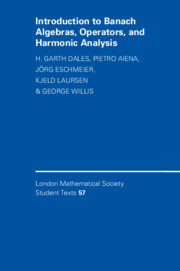Book contents
- Frontmatter
- Contents
- Preface
- Part I Banach algebras
- Part II Harmonic analysis and amenability
- Part III Invariant subspaces
- Part IV Local spectral theory
- Part V Single-valued extension property and Fredholm theory
- 26 Semi-regular operators
- 27 The single-valued extension property
- 28 SVEP for semi-Fredholm operators
- Index of symbols
- Subject index
28 - SVEP for semi-Fredholm operators
Published online by Cambridge University Press: 29 December 2009
- Frontmatter
- Contents
- Preface
- Part I Banach algebras
- Part II Harmonic analysis and amenability
- Part III Invariant subspaces
- Part IV Local spectral theory
- Part V Single-valued extension property and Fredholm theory
- 26 Semi-regular operators
- 27 The single-valued extension property
- 28 SVEP for semi-Fredholm operators
- Index of symbols
- Subject index
Summary
In Chapter 27 we established many conditions which imply SVEP at a point. The main goal of this chapter is to show that all these implications become equivalences for an important class of operators, the class of all semi-Fredholm operators. It will be also shown that, for these operators, SVEP at a point λ0 ∈ ℂ is equivalent to the finiteness of two important quantities, the ascent and the descent of the operator λ0I – T. These equivalences also provide useful information on the fine structure of the spectrum. In particular, we shall show that many spectra originating from Fredholm theory coincide whenever T or T′ have SVEP.
Ascent, descent, and semi-Fredholm operators
Let us recall the definition of some classical quantities associated with an operator. Given a linear operator T on a vector space X, it is easy to see that ker for every n ∈ ℕ.
Definition 28.1.1The ascent of T is the smallest positive integer p = p(T), whenever it exists, such that ker Tp = ker Tp+1. If such p does not exist, set p = ∞. Analogously, the descent of T is defined to be the smallest integer q = q(T), whenever it exists, such that. If such q does not exist, set q = ∞. If both p(T) and q(T) are finite, then T has finite chains.
- Type
- Chapter
- Information
- Publisher: Cambridge University PressPrint publication year: 2003



